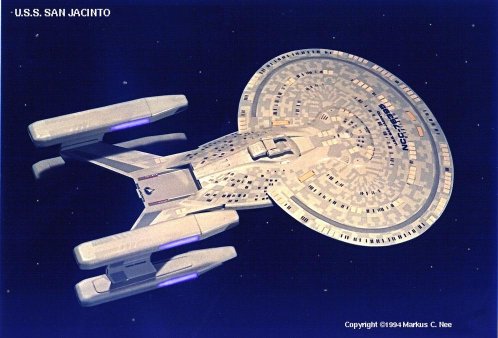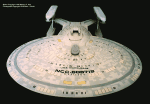Navigation
Home Page
Art Page
Starship Index
Starship Pages
Original designs
Colorado (CG)
Other models
USS Mareja
Lafayette (CL)
Matson (FFH)
Auspicious (CX)
Floyd (CL)
Al Tsahir (FFG)
Endurance (CG)
IKS Kre'vok
USS New Jersey
USS Shenandoah
USS Chicago
USS Independence
Colorado-class high speed cruiser

U.S.S. San Jacinto NCC-76395
Specifications |
|
|---|---|
| Type: | high speed cruiser/EW cruiser |
| Entered service: | 2369 |
| Mass: (standard) (full load) |
2,579,360 metric tons 2,860,022 metric tons |
| Length: | 579 m (1892 ft) |
| Width: | 378 m (1240 ft) |
| Height: (standard) (EW configuration) |
97 m (317 ft) 242 m (796 ft) |
| Complement: | 606 (76 officers) |
| Maximum Speed: | ~5000 c |
Programmes:
Naval Construction Contracts have been awarded for thirty-two hulls through FY 2379. Average completion rate is 3.5 starships per year total from three assembly yards (Port Brasta, Alpha Centauri; San Francisco Fleet Yards, Earth; and Antares Ship Yards) using components from twenty-three major subcontractors.
History and Operation:
The Colorado class starships combine the size and capacity of a medium-heavy cruiser with the performance of smaller quad-nacelled vessels such as the Constellation and Cheyenne classes. Development at the Advanced Starship Design Board began in 2360, and the class vessel, NX-76350 was launched in 2367 and commissioned in 2369. The hulls are based on a scaled up version of the Curaçao-class electronics warfare destroyers. They serve dual roles in Starfleet, with some vessels assigned as explorers and others as cruisers.
Due to their ability to maintain high warp speeds for extended periods of time as well as their large hull volume available for laboratory space, Colorado class ships operated by the Galaxy Exploration Command are usually assigned to long duration, deep space exploration missions.
When operated by Starfleet's Military Operations Command, Colorado class cruisers are used primarily for extended patrol missions along hostile borders. Although they carry a good balance of offensive and defensive weaponry, they are more lightly armed than the comparably sized Nebula-class starships, and rely on speed and maneuverability more than heavy weapons and armor in combat situations.
Several vessels of the class are fitted with phased array subspace/realspace sensor and electronics pylons which resemble four large vertical fins extending from the secondary hull. These ships are designated electronics warfare cruisers and are used in various roles including early warning, stand-off and escort sensor jamming, and 'wild weasel' missions. Occasionally, ships of the class with the EW configuration are also operated by GALEXCOM as mobile deep space observatories.
GALEXCOM intends to operate these vessels as deep space explorers for the duration of their designed lifespan. MILOPSCOM will be converting the remaining cruiser versions to the EW configuration when the new, more capable Midway-class starships enter service to take over the quad-nacelled fast cruiser role.

See also a ventral view.
Naming:
Colorado-class vessels are named for famous cruisers of the past and states and provinces on Federation member worlds. Curaçao-class destroyers are named for islands and archipelagos on Federation member worlds. Some Colorado-class vessels were constructed under Curaçao-class contracts and have retained their former names.
Several known ships of the Colorado-class include:
- NCC-76350 U.S.S. Colorado
- NCC-76387 U.S.S. Sagatauk (Trek Writers Guild)
- NCC-76395 U.S.S. San Jacinto
- NCC-76719 U.S.S. Marquesas (USF Sim Group)
- NCC-76722 U.S.S. Catalunya (Yves Laumonnier)
- NCC-76725 U.S.S. Valiant (Niles Smith)
Image gallery:
 |
U.S.S. Marquesas is a typical example of a later production Colorado class starship. |
 |
Among the changes are the use of armored bridge modules first introduced on the Lafayette class light cruisers. |
 |
I relettered the San Jacinto model and had these photos taken for the U.S.S. Marquesas sim group at the USF. |
Model notes:
The Colorado-class cruiser was originally designed by Markus C. Nee in April 1993 as the Curaçao-class destroyer. It was scaled up to cruiser size and renamed in April 1994, when construction was started on the scale model, by Markus C. Nee. The model was completed in May 1994 and was officially unveiled at the June meeting of the Long Island Science Fiction Modeler's Association. The U.S.S. San Jacinto model is in 1:1400 scale, and is approximately 16" long.
Primary hull is a Galaxy class saucer from an AMT 1:1400 scale kit heavily modified. The secondary hull is also from a 1:1400 scale Galaxy class model. The neck was removed and the hull was grafted directly onto the back of the saucer, with heavy body filler work blending the two structures. Warp nacelles are vacuum formed copies custom made by Jeff Pollizzotto, based off of wooden masters I carved. The finish is airbrushed Testors Model Master enamel paints, Letraset and Chartpak dry transfer lettering, and AMT decals.
Here's a link to "San Jack's" namesake, CG-56.
All original materials on this web page, unless otherwise noted, are
Copyright 1997 Markus C. Nee. All rights reserved. Ask for my
permission before using any of my work. Thanks.
This page was last modified 2000-06-06.
If you would like
to use a starship of this class for storywriting, role-playing, or
fan club purposes, let me know so I can keep track of names and registries.